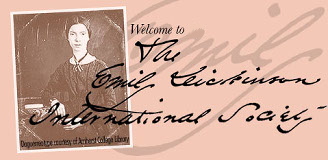
You are hereKuhn, Mary: "Every flower that grows from Amherst to Cashmere: Dickinson’s Global Floral Network"
Submitted by RFranz on July 18, 2013 - 5:51pm
Every flower that grows from Amherst to Cashmere: Dickinson’s Global Floral NetworkMary Kuhn, Boston University No major nineteenth-century American author demonstrates better than Dickinson the cosmopolitanism of botanical discourse in the nineteenth century. Dickinson’s poetry interrogates the relationship between landscape design and science, and this paper contextualizes Dickinson’s poetry in regard to her interest in the close observation of plants. Her detailed botanical vocabulary and references to microscopes and other instruments of study turn the garden into a realm of scientific scrutiny. At the same time, as Nina Baym has pointed out, Dickinson uses her poetic proofs to rebuff the popular trend at Amherst College and throughout the Western world to justify faith with scientific logic. Often categorized as a recluse and poet of a limited environmental range, Dickinson’s interest in plants is far from domestic. Rather, it extends the range of her geographical (and one could argue, geopolitical) interests. While Dickinson interrogates scientific terminology (J100, J168 are just two examples), this same terminology also services her practice of plant collection. I argue that her interest in botany connects Dickinson to the cosmopolitan system of plant gathering; her herbariums contain samples of flowers in her garden, but also species sent to her by friends in Syria, Lebanon, Greece and other Southern European and Middle Eastern climes. These flowers, neatly classified and mounted, influence the scope of Dickinson’s spatial relations; as J180 suggests, she is attentive to flowers uprooted: “As if some little Arctic flower / Upon the polar hem -- / Went wandering down the Latitudes / Until it puzzled came / To continents of summer -- / To firmaments of sun -- / To strange, bright crowds of flowers -- / And birds, of foreign tongue!” Flower imagery, and the garden atmosphere more generally, allows Dickinson to link the scenery in Amherst, Haworth, Saint Domingo, Cashmere, and beyond. Given that Amherst College in the mid-nineteenth century fostered a large number of missionaries, that Dickinson knew many of them, and that her poems reference geographical expanse through flora, I read her attention to plants as an engagement with the global local. Prolific during the country’s bloodiest conflict to date, Dickinson forges links between local and foreign plants in her poems to speak about conflict in the public sphere, suggesting that her engagement with the Civil War is more direct and expansive than is it is often thought to be.
|